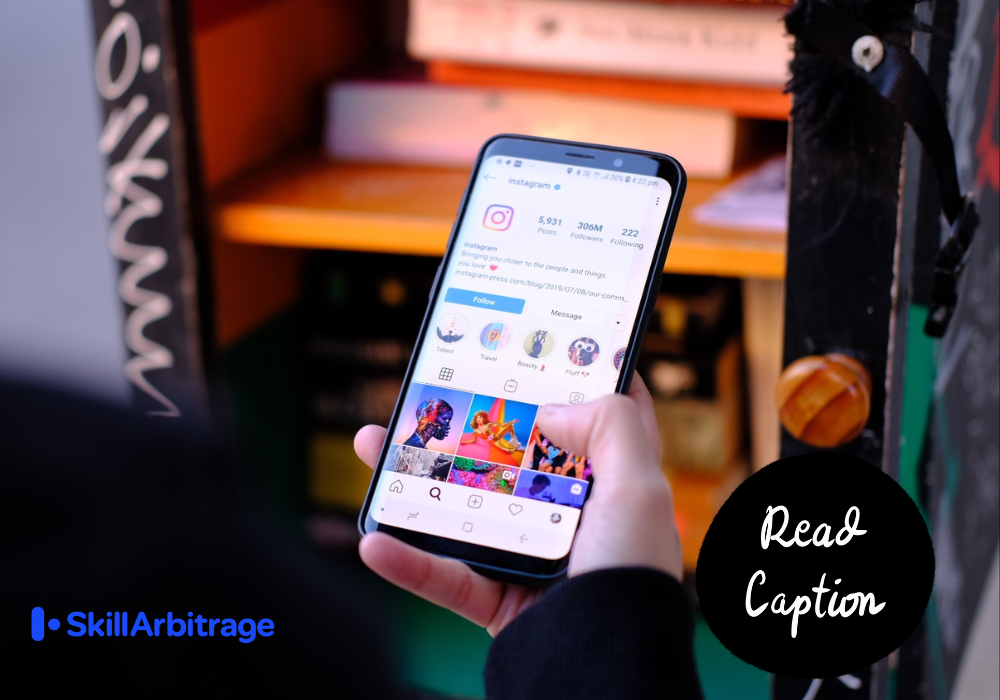This blog is your ultimate 30-minute blueprint to generate a full month’s worth of high-performing Instagram captions—using AI. Whether you’re a content writer, social media manager, marketing head, or small business owner, you’ll learn how to craft scroll-stopping, brand-ready captions in minutes, not hours.
Table of Contents
Written by Sunayani Ganguly
Introduction
The situation was grave and steadily becoming graver. It was a Sunday evening, and I was staring at the almost entirely empty content calendar. I had to get this done seven days earlier, but some procrastination mixed with a slight writer’s block has landed me in the present predicament.
Tomorrow is Monday, and my client’s posting schedule was supposed to start, AND I haven’t written a single caption.
I had to do something, and I subsequently found a way to do it in 30 minutes straight.
But tell me first, did my situation seem familiar to you?
Writing 30 brand-aligned Instagram captions can feel like an endless slog, hours spent crafting each post, second-guessing every emoji, and wondering if your audience will engage.
But now, in the era of AI, such situations are entirely avoidable.
Here is the breaking news!
AI has completely transformed caption creation, turning what used to be a time-consuming struggle into a streamlined, creative process that delivers engaging captions in minutes.
In this guide, I will tell you how to craft an entire month’s worth of captions specifically tailored for Indian lifestyle, fashion, edtech, and SaaS brands.
We are not talking about generic, robotic content; we are talking about captions that sound authentic to you while speaking directly to your Indian audience.
Why captions are major engagement drivers
Let’s get one thing straight: captions aren’t just filler text to accompany your pretty pictures. They are the secret weapon that sparks saves, shares, and clicks. In the world of Instagram marketing, captions are where the magic happens.
Instagram’s algorithm has become incredibly sophisticated, and it rewards content that keeps people engaged.
The platform tracks dwell time, how long someone stays on your post, and conversation starters that generate meaningful interactions. A stunning photo might stop the scroll, but a compelling caption is what transforms that pause into engagement. Surveys reveal that including a caption can significantly increase your engagement rates, pushing them from roughly 5.38% to above 6.7%.
The four core purposes of content
Your captions should serve one of four core purposes, and the best ones often accomplish multiple goals simultaneously:
Education
Educate your audience by sharing valuable tips, insights, or behind-the-scenes knowledge that they can’t get anywhere else. Think quick tutorials, industry secrets, or myth-busting content.
Entertainment
Entertain your audience with humor, wit, or storytelling that makes people smile, laugh, or feel emotionally connected to your brand. This is where personality shines through.
Inspiration
Inspire your followers to take action, think differently, or pursue their goals. Motivational content performs incredibly well, especially when it feels authentic rather than preachy.
Conversion
Convert browsers into customers by driving them to your DMs, website, or latest offering. The key is making the transition feel natural, not pushy.
For Indian brands, adding relatable local context can dramatically boost engagement. Using familiar slang like “bhai,” “desi vibes,” or references to shared cultural experiences creates an instant connection with your audience.
When your followers see themselves reflected in your captions, they’re far more likely to engage.
Diverse captions for different industries
Different industries require different approaches to caption writing, and understanding these nuances is crucial for creating content that resonates. Let’s break down the most effective caption strategies for four major sectors in the Indian market.
- Lifestyle brands thrive on storytelling and community vibes. Your captions should feel like conversations with a close friend who gets your daily struggles and celebrations. Focus on relatable experiences, seasonal moments, and emotional connections.
Example: “Stressed about Monday blues? Skip the overthinking, grab your chai, and remember, you’ve survived 100% of your worst days. #DesiVibes #MondayMotivation”
This works because it acknowledges a universal experience (Monday stress), offers a culturally relevant solution (chai), and provides gentle encouragement without being overly motivational.
- Fashion brands should focus on outfit inspiration, styling tips, and seasonal hooks that help followers visualize themselves wearing your pieces. The key is making fashion feel accessible and achievable, not intimidating.
Example: “Diwali party coming up? Ditch the confusion and rock a festive kurta that screams ‘main character energy.’ Because overdressed is a myth when you’re celebrating. #StyleGoals #FestiveFashion”
- Edtech brands perform best with microlearning content and transformation stories that inspire without overwhelming. Your captions should position education as empowering rather than intimidating.
Example: “Remember when math felt impossible? Plot twist: You just needed the right approach. From zero to JEE hero is possible; we’ve seen it happen 1000+ times. #MathMadeEasy”
- SaaS brands need to strike a balance between empathizing with pain points and demonstrating thought leadership. Your audience wants to feel understood while seeing you as the expert who can solve their problems.
Example: “Juggling 15 different productivity tools? Same energy as using 10 apps to order one meal. Simplify your workflow, multiply your results. #StartupIndia”
The secret sauce across all industries is aligning your content with Indian trends and cultural moments. Festive seasons, exam periods, monsoon months, and cricket tournaments all provide natural hooks for timely, relevant content.
30-minute workflow to generate captions
Now, for the main event: the exact process that’ll transform your caption creation from a time-consuming chore into an efficient and creative system.
This workflow is designed to be repeatable, scalable, and flexible enough to work for any brand personality.
Step 1: Define content pillars (5 minutes)
Start by identifying 3-5 content buckets that align with your brand strategy. These pillars ensure variety while maintaining focus. Common pillars include product spotlights, user-generated content, educational tips, behind-the-scenes, and community features.
Use this prompt: “Suggest 5 post themes for an Indian [skincare/edtech/fashion] brand targeting Gen Z professionals.”
For example, a skincare brand might get: Product education, Skincare myths, Routine tips, Ingredient spotlights, and Customer transformations. These pillars become your content foundation, ensuring you never run out of ideas.
Step 2: Build your prompt stack (10 minutes)
This is where you create your AI toolkit, a collection of prompts that consistently deliver high-quality results. Think of this as building your creative arsenal.
Caption Type Prompts: “Write 5 witty captions for a [fashion brand] in a bold, Gen-Z tone focusing on confidence and self-expression.”
Hashtag Prompts: “Suggest 10 relevant hashtags for an Indian [SaaS brand] focused on productivity tools for remote workers.”
CTA Prompts: “Add 3 different call-to-action options to this caption: ‘New online course launching next week!'”
The beauty of building a prompt stack is reusability. Once you’ve tested and refined prompts that work for your brand, you can use them repeatedly with different topics and products.
Step 3: Batch generate (10 minutes)
This is where the magic happens.
Using tools like ChatGPT, Copy.ai, or Claude, generate 6 captions per content pillar using different styles: inspirational, witty, question-based, educational, storytelling, and promotional.
Run your prompts systematically, focusing on quantity over perfection at this stage.
You are creating raw material that you’ll refine in the next step. Store everything in Google Sheets or Notion for easy organization and future reference.
Pro tip: Generate variations by asking for different tones or approaches. “Make this more conversational,” “Add humor to this caption,” or “Rewrite this for a premium audience” can give you multiple options from a single base idea.
Step 4: Polish & personalize (5 minutes)
Now comes the human touch that transforms AI output into authentic brand content. Edit each caption for your specific brand voice, add relevant Indian slang or cultural references, and ensure the emoji balance feels natural rather than overwhelming.
If you want to follow this entirely for free, use these free AI tools for individual steps:
Always remember, AI generates drafts in minutes, but your brand’s voice and cultural flair make them shine.
Use prompts like: “Make this caption more conversational for Indian millennials working in tech,” or “Add cultural references that would resonate with young professionals in Mumbai and Bangalore.”
Test each caption’s length (aim for under 150 words for optimal engagement) and ensure the hook, your opening line, is strong enough to stop the scroll. The first sentence is crucial; if it doesn’t grab attention immediately, the rest doesn’t matter.
Reusable caption frameworks
Having proven formulas in your back pocket eliminates guesswork and speeds up your creation process. These frameworks work across industries and can be adapted to any brand voice.
Here are the prompts that you can use to generate captions according to each of the frameworks.
Problem, setup, CTA framework
Prompt: “Write a problem-solution caption for [brand] that acknowledges [specific customer pain point] and offers [solution].”
Stat, shock, CTA framework
Prompt: “Find a relevant statistic about [industry problem] and create a caption that positions [brand] as the solution.”
Story, hook, sell framework
Prompt: “Write a story-driven caption featuring a customer success story that leads to [specific CTA].”
Question, insight, CTA framework
Prompt: “Create a question-based caption for [fashion/lifestyle brand] that sparks curiosity and leads to [desired action].”
Automation tricks for workflow optimization
Once you’ve created your month of captions, smart organization and automation can save you even more time while ensuring consistency across your posting schedule.
Google Sheets organization is your foundation. Create columns for posting date, content pillar, caption text, hashtags, and any specific notes or reminders. This visual overview helps you ensure variety and balance across your content calendar.
Zapier integration with scheduling tools like Later or Hootsuite can create automated reminders for content review, posting confirmations, or team notifications. Set up triggers that alert you when it’s time to prepare next month’s content or when engagement on recent posts needs attention.
Template creation with merge tags streamlines future caption generation. Create frameworks like “[Product name] solves [specific pain point] for [target audience]. [Emotional benefit] + [logical reason]. [Strong CTA] [relevant emoji].”
Use this prompt: “Generate 5 reusable caption templates for [Indian lifestyle brand] that can be customized for different products and campaigns.”
Team Collaboration through Notion allows multiple team members to contribute ideas, edit captions, and track approval status. Create templates that include brand voice guidelines, approved hashtags, and cultural context notes for consistency.
Avoid these pitfalls
Even with AI as your creative partner, several common mistakes can derail your caption strategy and hurt your engagement rates.
Using unedited AI outputs is the biggest mistake. AI-generated content often sounds robotic or generic without human refinement. Always edit for personality, brand voice, and natural conversation flow.
Overloading with hashtags and emojis makes your captions look spammy and unprofessional. Stick to 5-10 relevant hashtags and use emojis strategically for emphasis, not decoration.
Missing the Indian cultural context is particularly dangerous for brands targeting local audiences. AI might miss important cultural nuances, festive timing, or regional preferences that could make or break your engagement.
Skipping fact-checking can damage your credibility. AI sometimes invents statistics or makes claims that aren’t accurate. Always verify facts, especially for educational or industry-specific content.
Ignoring audience feedback means missing opportunities to refine your approach. Use Instagram Stories polls to test caption styles, ask followers what content they want to see, and pay attention to which posts generate the most meaningful engagement.
30-minute caption workflow template
Here’s your step-by-step template for creating a month of captions in 30 minutes:
Minutes 1-5: List your 5 content pillars and ensure they align with your brand strategy and audience interests.
Minutes 6-15: Generate 6 captions per pillar using your proven AI prompts, focusing on variety in tone and approach.
Minutes 16-20: Apply one framework per caption to ensure structure and flow that leads to engagement.
Minutes 21-25: Add relevant hashtags and CTAs using targeted prompts for each post type.
Minutes 26-30: Edit all captions for Indian audience preferences, adding local slang, cultural references, and emoji balance.
Bonus step: Schedule everything in your preferred tool (Later, Hootsuite, or Buffer) and set reminders for engagement monitoring.
Here’s a quick recap of the process:
Result: 30 scroll-stopping, engagement-driving captions ready to post, plus a system you can repeat monthly with increasing efficiency and effectiveness.
Conclusion
AI has fundamentally transformed caption creation from a time-consuming chore into an efficient, creative process that actually enhances your brand voice rather than diluting it.
When you batch 30 captions in 30 minutes, you are not just saving time; you are creating space for strategy, community engagement, and the kind of deep work that grows your brand.
The numbers speak for themselves: engaging captions boost post saves by 66% according to Sprout Social’s 2024 research.
In a platform where it saves signal high-value content to the algorithm, this isn’t just about efficiency – it’s about amplifying your reach and impact.
Your next content planning session is the perfect opportunity to test this workflow. Start with the 30-minute framework, experiment with different prompt variations for your industry, and watch as your caption creation process transforms from a weekly stress into a monthly power hour that sets you up for consistent, engaging content.
In India’s vibrant and competitive social media landscape, where every brand is fighting for attention and engagement, sharp captions that speak directly to your audience’s experiences and aspirations can make your brand truly unforgettable.
FAQs
Q: Will AI-generated captions sound robotic and hurt my brand’s authentic voice?
A: Not if you follow the workflow correctly. The key is using AI for ideation and structure, then editing heavily for your brand voice. Think of AI as providing the skeleton – you add the personality, cultural context, and authentic touches that make captions sound like you. Always spend those final 5 minutes personalizing each caption with your brand’s tone, local references, and natural conversation style. The goal is AI-assisted, not AI-written content.
Q: How do I ensure my captions work for both Hindi and English-speaking audiences in India?
A: Focus on universal emotions and experiences while strategically mixing languages. Use English as your base but incorporate Hindi words that have crossed into mainstream usage like “bhai,” “desi,” “jugaad,” or “bindaas.”
Avoid complex Hindi phrases that might alienate English-only speakers. Test your captions with team members from different linguistic backgrounds, and consider creating separate caption variations for purely Hindi-speaking regions if that’s a significant part of your audience.
Q: Which AI tools work best for Instagram caption generation, and are there free options?
A: ChatGPT (free tier available) and Claude work excellently for caption generation. Copy.ai and Jasper are paid options with Instagram-specific templates. For free alternatives, try ChatGPT’s free version, Google’s Bard, or even Instagram’s native AI features. The tool matters less than your prompts – a well-crafted prompt in ChatGPT often outperforms expensive tools with poor prompts. Start free, test what works, then upgrade if needed.
Q: How do I avoid creating captions that look like every other brand using AI?
A: Personalization is everything. Never use AI output directly – always add your brand’s unique perspective, industry-specific insights, and cultural context. Create custom prompt templates that include your brand voice guidelines. Reference specific Indian experiences, current events, or industry trends that AI wouldn’t naturally include. The more specific and personal your editing process, the more unique your captions become.
Q: What’s the ideal caption length and hashtag strategy for maximum engagement in the Indian market?
A: Aim for 125-150 words for optimal engagement – long enough to tell a story but short enough to maintain attention. For hashtags, use 5-10 highly relevant ones rather than the maximum 30. Mix popular hashtags (#IndianFashion, #MumbaiStyle) with niche ones (#SustainableBeautyIndia, #JEEPrep2024) and branded hashtags. Indian audiences respond well to storytelling, so don’t be afraid of slightly longer captions if they serve a purpose. Always test with your specific audience and adjust based on performance data.







 Allow notifications
Allow notifications
